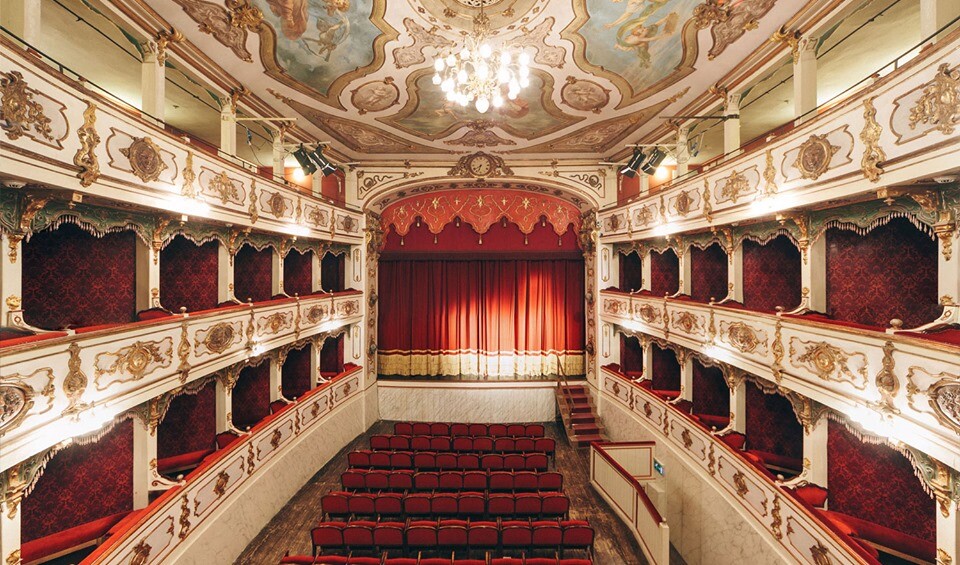In Busseto, once the capital of Stato Pallavicino, (almost) everything revolves around the figure of Giuseppe Verdi. The main square is dedicated to the famous composer, who was born in the nearby hamlet of Roncole in 1813. The square is dominated by a bronze monument, created by the sculptor Luigi Secchi in 1913, which depicts the maestro watching over the town, quietly perched on a chair, looking like he is about to get up at any moment to accompany you in your discovery of the town.
In the square, we see the 11th century fortress which was once home to the Pallavicino family, and is now home to the municipality. We also see the Teatro Verdi, a theatre inaugurated in 1868, and Casa Barezzi, where Verdi lived with his wife Margherita Barezzi. The house holds numerous relics testament to his training and career, signed letters, documents and portraits of the maestro.
If you decide to visit Busseto, take a walk around the village and the historical centre which is adorned with beautiful buildings, period houses and long streets with medieval porticos, the most notable of which is Via Roma, the main street. Here you will find Palazzo Orlandi: rebuilt in neoclassical style at the beginning of the 19th century, it was bought by Verdi in 1845, where he lived with the opera singer Giuseppina Strepponi from 1849 to 1851, before moving to the nearby Sant’Agata estate in Villanova D’Arda. The country home in which the maestro lived in his later years is not situated in the province of Parma, but is still linked to the “Terre di Verdi”, with its untouched furnishings and many relics.
Just a few steps from Piazza Verdi, an interesting stop to make is at the ‘Baratta’ historical inn, which since 1873 has been welcoming locals (including, of course, Giuseppe Verdi) wishing to try local products accompanied by local wine, all accompanied by the sounds of Verdi’s music. Continuing with the “Verdi” itinerary, you will find Villa Pallavicino, just outside the historical centre of Busseto.
Built in Renaissance style, the villa was bought by the Pallavicino family in around 1530 who made it their summerhouse. Towards the end of the 17th century, it was decorated by various artists who painted frescoes and created stuccos in baroque and rococo style. Since 2009 it has been the site of the Giuseppe Verdi National Museum. The ample rooms paint a picture of Verdi’s 27 works, with original scenography from Casa Ricordi, historical paintings, fabric from the 1800s as well as his immortal music, all adorned with theatrical lighting accompanying the visitor on anintensely romantic journey.
In the park, we also see the Palazzo delle Scuderie which since 2014 has been home to the Renata Tebaldi Museum: dedicated to the famous soprano, it is home to a fascinating range of exhibits with objects, outfits and jewels that belonged to the “Voice of the Angels” (as nicknamed by orchestra director Arturo Toscanini), as well as documents, images and testimonies from famous artists and Tebaldi’s colleagues.
However, the town is not only home to things relating to Verdi! It hosts other historic and artistic relics which make its patrimony even richer.
Starting off is the 14th century San Bartolomeo Church, built on the remains of the previous church, is characterised by its Renaissance structure, with stuccos and paintings; the Church of Saint Mary of the Angels with the famous sculpture of Compianto; as well as the church of Sant’Ignazio, with its Baroque interior and fascinating frescoes. There is also the Monte di Pietà Palace, built between 1679 and 1682 in Baroque style, which is now home to many prestigious works and the rich library of the Fondazione Cariparma, containing over 40,000 volumes, among which are the musical manuscripts of the Busseto Philharmonic.
Only 5km from Busseto is the small hamlet of Roncole Verdi, home to the maestro’s birth house. The house today is host to a multimedia exhibition which recreates the atmosphere the maestro experienced in his first years of life. Linked to Verdi’s fame is nearby St Michael’s Church [Chiesa di San Michele], from the 16th – 17th century, which is where Verdi was baptised. Inside the church, you can visit the organ where Verdi had his first music lessons, under the guidance of Don Pietro Baistrocchi.
Another famous face is Giovannino Guareschi, author of the Don Camillo and Peppone stories, who, a fact not known to many, lived in Roncole for many years of his life. He was native to the nearby Fontanelle, but in 1952 bought a plot of land on the edge of the hamlet on which he built his house. In 1957 he opened an inn a few steps away from Verdi’s birthplace, which remained in the family until 1995 when it was handed over to the “Club dei Ventitré”, an association of friends and enthusiasts of the writer. Inside the inn there is a permanent exhibition dedicated to Guareschi, displaying numerous books, drawings, letters, photographs and prints of the author. He was laid to rest in the small cemetery in Roncole, and his tomb is adorned with a bronze sculpture depicting the author’s face, created by the famous local artist Luigi Froni.
If you find yourself around Busseto, visit the Corte delle Piacentine, the set of many scenes in the famous 1975 film “1900” directed by the director and Oscar winner Bernardo Bertolucci. Numerous stars from the world of cinema worked on the set, namely Robert De Niro, Gèrard Depardieu, Stefania Sandreli and Donald Sutherland. Additionally, we can’t forget Vittorio Storaro for the photography, and Ennio Morricone for the soundtrack.
Finally, Busseto is also one of the stops on the Strada del Culatello and other enogastronomical delights typical of the lowlands, all of which will delight your tastebuds!



